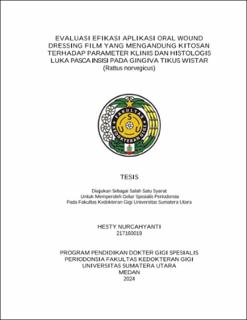| dc.description.abstract | Background: Periodontal surgical treatment causes an incised wound which has the potential for complications of bleeding, swelling and infection which can delayed the healing process so that a periodontal dressing is needed to cover the surgical area. Periodontal dressings in film preparation can be an option that is considered more aesthetic and easier to apply. Chitosan is effective in accelerating wound healing, because it has mucoadhesive, bioactive, biocompatible, biodegradable, antimicrobial and non-toxic properties. Objective: To analyze the effectiveness of Oral Wound Dressing Chitosan Film on epithelial thickness, collagen density and vascularization in the wound healing process after wistar rat gingival incision. Methods: In vivo laboratory experimental research with a post-test control group design of 45 male wistar rats aged 2-3 months in three treatment groups with Oral Wound Dressing Film chitosan, Ora-Aid® and placebo. Clinical parameters were examined with the Landry Healing Index and histological parameters of epithelial thickness, collagen density and vascularization on days 3, 7 and 14. Data were analyzed using One-Way ANOVA and Kruskal-Wallis statistical tests to see differences between groups followed by post-hoc LSD and Mann-Whitney tests for comparisons between two groups. Results: One-Way ANOVA and Kruskal-Wallis tests showed that there were significant differences in epithelial thickness, collagen density and vascularization between the Oral Wound Dressing Film chitosan, Ora-Aid® and placebo groups on days 3, 7 and 14 (p<0.05). Post-hoc LSD and Mann-Whitney tests showed that there were differences in epithelial thickness, collagen density and vascularization (p<0.05) between the two groups except for epithelial thickness on day 3 and vascularization on days 3, 7 and 14 in the Oral Wound Dressing Film chitosan and Ora-Aid® groups (p>0.05). Conclusion: Application of Oral Wound Dressing Chitosan Film can effectively on wound healing process after gingival incision in wistar rats clinically and histologically. | en_US |


